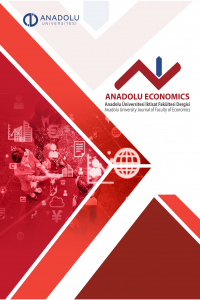Energy Sector’s Monopoly Rent-seeking and Supplementary Time-series Analysis in the Case of Azerbaijan
In this paper, energy sector’s monopoly behavior is analyzed in the case of Azerbaijan by referring to the literature of Dutch disease and rent-seeking. As a theoretical background, a new general equilibrium model is also developed in order to explain unusual surge of gasoline prices in Azerbaijan during the decreasing global oil prices. The paper shows the relationship between crude oil price and local gasoline prices (rent-seeking in this paper). There is a cointegrating relation between two variables under Johansen Cointegration Test and it supports the idea in the theoretical general equilibrium model. Monopolies use higher local gasoline prices as rent-seeking during decreasing crude oil prices for covering their losses due to diminishing revenues from oil exports.
Anahtar Kelimeler:
Monopoly, Rent-seeking, Dutch disease, Natural Resources, Energy
Energy Sector’s Monopoly Rent-seeking and Supplementary Time-series Analysis in the Case of Azerbaijan
In this paper, energy sector’s monopoly behavior is analyzed in the case of Azerbaijan by referring to the literature of Dutch disease and rent-seeking. As a theoretical background, a new general equilibrium model is also developed in order to explain unusual surge of gasoline prices in Azerbaijan during the decreasing global oil prices. The paper shows the relationship between crude oil price and local gasoline prices (rent-seeking in this paper). There is a cointegrating relation between two variables under Johansen Cointegration Test and it supports the idea in the theoretical general equilibrium model. Monopolies use higher local gasoline prices as rent-seeking during decreasing crude oil prices for covering their losses due to diminishing revenues from oil exports.
Keywords:
Monopoly, Rent-seeking, Dutch disease, Natural Resources, Energy,
___
- ADB (2022). Poverty Azerbaijan. https://www.adb.org/countries/azerbaijan/poverty#:~:text=Poverty%20Data%3 %20Azerbaijan, force%20in%202019%20is%20unemployed [Accessed: 19th January, 2022].
- Antwi, A., & Adams, J. (2003). Rent-seeking behavior and its economic costs in urban land transactions in Accra, Ghana. Urban Studies, 40(10), 2083-2098.
- Auty, R. M. (2001a). The Political Economy of Resource-Driven Growth. European Economic Review, 45(4-6), 839-846.
- Auty, R. M. (2001b). Resource Abundance and Economic Development. Oxford and New York: Oxford University Press.
- Bruggemann, R., Lütkepohl, H., & Saikkonen, P. (2006). Residual autocorrelation testing for vector error correction models. Journal of Econometrics, 134(2), 579-604.
- Calderon, C., & Chong, A. (2007). Rent seeking and democracy: empirical evidence for Uruguay. Economic Inquiry, 45(3), 592-601.
- Caselli, F., & Michaels, G. (2013). Do Oil Windfalls Improve Living Standards? Evidence from Brazil. American Economic Journal: Applied Economics, 5(1), 208-238.
- Cole, I. M., & Chawdhry, M. A. (2002). Rent seeking and economic growth: evidence from a panel of U.S. states. The Cato Journal, 22(2), 211-228.
- Corden, W. M., & Neary, J. P. (1982). Booming Sector and De-Industrialization in a Small Open Economy. The Economic Journal, 92(368), 825-848.
- Corden, W. M. (1984). Booming Sector and Dutch Disease Economics: Survey and Consolidation. Oxford Economic Papers, New Series, 36(3), 359-380.
- Del Rosal, I. (2011). The Empirical Measurement of Rent-seeking Costs. Journal of Economic Surveys, 25(2), 298-325.
- Doornik, J.A., & Hansen, H. (2008). An Omnibus test for univariate and multivariate normality. Oxford Bulletin of Economics and Statistics, 70, 927-939.
- Hendry, D. F., & Juselius, K. (2000). Explaining cointegration analysis: Part I. Energy Journal, 21, 1-42.
- Hendry, D. F., & Juselius, K. (2001). Explaining cointegration analysis: Part II. Energy Journal, 22, 75-120.
- Ibadoglu, G. (2008). Contract of the Century: Myths and Realities. Transition Studies Review, 15, 425-430.
- Johnston, J., & Dinardo, J. (1996). Econometric Methods. (4th ed.) New York: McGrawHill/Irwin.
- Laband, D. N., & McClintock, G. C. (2001). The Transfer Society. Washington, DC: Cato Institute.
- Liebman, B. H., & Reynolds, K. M. (2006). The returns from rent-seeking: campaign contributions, firm subsidies and the Byrd Amendment. Canadian Journal of Economics, 39(4), 1345-1369.
- Mixon, F. G. (2002). Social security trust fund flows and the welfare costs of rent seeking. Applied Economics, 34(8), 975-979.
- Muradov, A. (2018). Costly independence for oil-rich Azerbaijan: Khojaly Massacre. Why could it be considered as genocide?. ARHUSS, 1(3), 147-162.
- Muradov, A. (2021). The Importance of Natural Resources for The Azerbaijani Economy. Economics, Business and Organization Research, 3(1), 117-131.
- Reynolds, K. M. (2006). Subsidizing rent-seeking: antidumping protection and the Byrd Amendment. Journal of International Economics, 70(2), 490-502.
- Rosenberg, C., & Saavalainen, T. (1998). How to Deal with Azerbaijani Oil Boom? Policy Strategies a Resource-Rich Transition Economy. IMF Working Paper, 98(6).
- Sala-i-Martin, X., & Subramanian A. (2003). Addressing the Natural Resource Curse: An Illustration from Nigeria. National Bureau of Economic Research Working Paper, 9804.
- Sobel, R. S., & Garrett, T. A. (2002). On the measurement of rent seeking and its social opportunity cost. Public Choice, 112, 115-136.
- Stokke, H. E. (2008). Resource Boom, Productivity Growth and Real Exchange Rate Dynamics- A Dynamic General Equilibrium Analysis of South Africa. Economic Modelling, 25(1), 148-160.
- Torvik, R. (2002). Natural resources, rent seeking and welfare. Journal of Development Economics, 67(2), 455-470.
- Van der Ploeg, F. (2011). Curse or Blessing?. Journal of Economic Literature, 49(2), 366-420.
- Wooldridge, J. M. (2015). Introductory Econometrics: A Modern Approach. (6th ed.) Boston: Cengage Learning.
- World Bank (2022). Azerbaijan. https://www.worldbank.org/en/country/azerbaijan/[Accessed: 19th January, 2022].
- Yayın Aralığı: Yılda 2 Sayı
- Başlangıç: 2019
- Yayıncı: Anadolu Üniversitesi
Sayıdaki Diğer Makaleler
Ülkelerin Yönetişim Düzeyleri ile Ekonomik Büyümeleri Arasındaki İlişkinin Analizi
